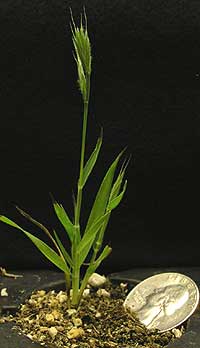 The temperate wild grass species Brachypodium distachyon (Brachypodium) is a new model plant for temperate grasses and herbaceous energy crops. Temperate grass species such as wheat, barley, and forage grasses underpin our food supply. However, the size and complexity of their genomes is a major barrier to biotechnological improvement. Similarly, while herbaceous energy crops (especially grasses) are poised to become a major source of renewable energy in the United States, we know very little about the biology of traits that affect their utility for energy production. Thus a tractable temperate grass model is urgently needed to address questions directly relevant both for improving grain crops and forage grasses that are indispensable to our food production systems, and for developing grasses into superior energy crops. Neither rice nor Arabidopsis adequately fits this role.
The temperate wild grass species Brachypodium distachyon (Brachypodium) is a new model plant for temperate grasses and herbaceous energy crops. Temperate grass species such as wheat, barley, and forage grasses underpin our food supply. However, the size and complexity of their genomes is a major barrier to biotechnological improvement. Similarly, while herbaceous energy crops (especially grasses) are poised to become a major source of renewable energy in the United States, we know very little about the biology of traits that affect their utility for energy production. Thus a tractable temperate grass model is urgently needed to address questions directly relevant both for improving grain crops and forage grasses that are indispensable to our food production systems, and for developing grasses into superior energy crops. Neither rice nor Arabidopsis adequately fits this role.
Brachypodium is closely related to the cool-season grasses and is an emerging model system for the diverse and economically important grain, forage and turf crops that these groups encompass. The small Brachypodium genome can be used as an accurate template for the much larger polyploid genomes of crops such as wheat and barley. Moreover, since Brachypodium is inbreeding, small in stature, can be grown rapidly, and is amenable to transformation it can be used as a functional model to gain the knowledge about basic grass biology necessary to develop superior energy crops. This combination of desirable attributes underlies the burgeoning research interest in the species. A whole-genome shotgun sequence (WGS) of the Brachypodium Bd21 genome, supplemented by a complete set of expressed sequence tags (ESTs), will be a cornerstone resource for a vigorous research community seeking to promote the development of new energy crops and to contribute to global food security.
Principal Investigators: Jeff Chang (Oregon State Univ.), Michael Bevan (John Innes Centre), David Garvin (USDA-ARS), Samuel Hazen (Scripps Research Inst.), Todd Michael (Salk Inst.), Todd Mockler (Oregon State University), and John Vogel (USDA-ARS)